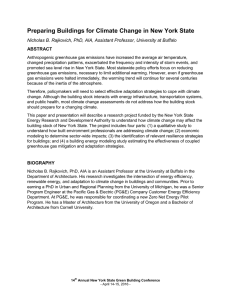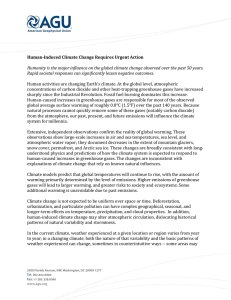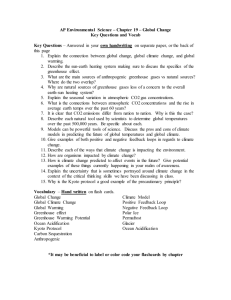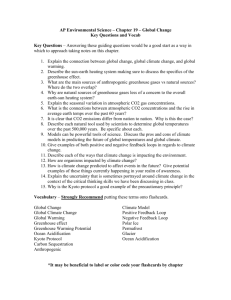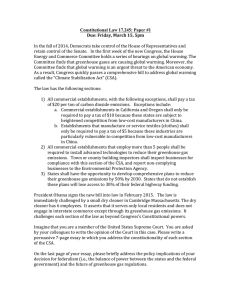Document 14531298
advertisement
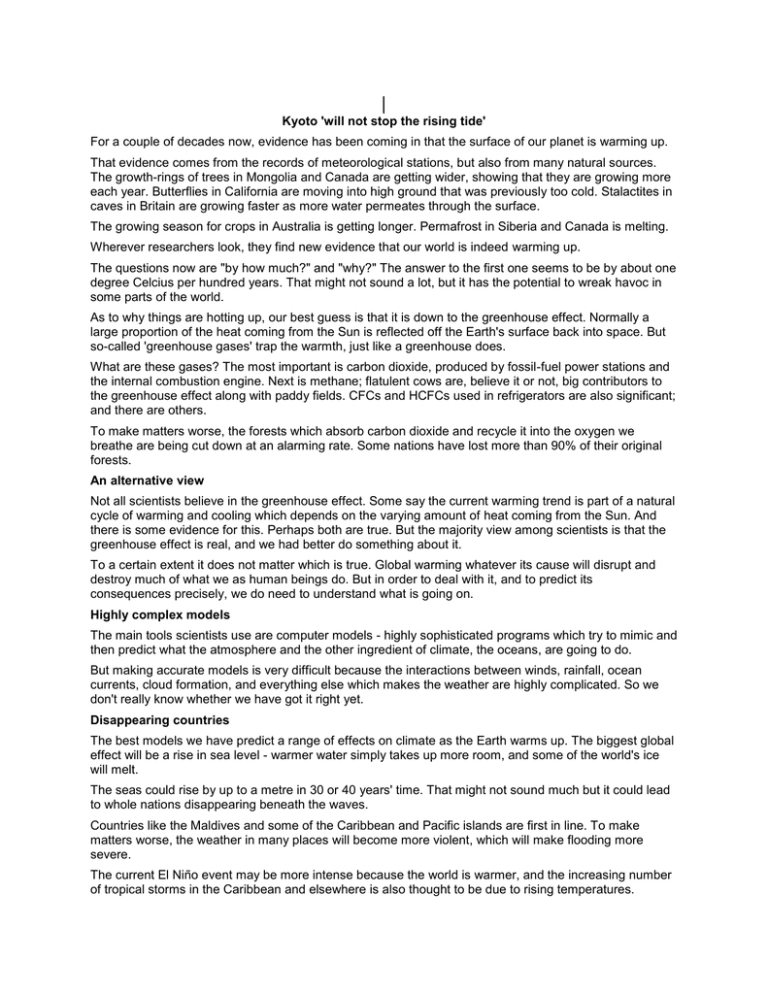
Kyoto 'will not stop the rising tide' For a couple of decades now, evidence has been coming in that the surface of our planet is warming up. That evidence comes from the records of meteorological stations, but also from many natural sources. The growth-rings of trees in Mongolia and Canada are getting wider, showing that they are growing more each year. Butterflies in California are moving into high ground that was previously too cold. Stalactites in caves in Britain are growing faster as more water permeates through the surface. The growing season for crops in Australia is getting longer. Permafrost in Siberia and Canada is melting. Wherever researchers look, they find new evidence that our world is indeed warming up. The questions now are "by how much?" and "why?" The answer to the first one seems to be by about one degree Celcius per hundred years. That might not sound a lot, but it has the potential to wreak havoc in some parts of the world. As to why things are hotting up, our best guess is that it is down to the greenhouse effect. Normally a large proportion of the heat coming from the Sun is reflected off the Earth's surface back into space. But so-called 'greenhouse gases' trap the warmth, just like a greenhouse does. What are these gases? The most important is carbon dioxide, produced by fossil-fuel power stations and the internal combustion engine. Next is methane; flatulent cows are, believe it or not, big contributors to the greenhouse effect along with paddy fields. CFCs and HCFCs used in refrigerators are also significant; and there are others. To make matters worse, the forests which absorb carbon dioxide and recycle it into the oxygen we breathe are being cut down at an alarming rate. Some nations have lost more than 90% of their original forests. An alternative view Not all scientists believe in the greenhouse effect. Some say the current warming trend is part of a natural cycle of warming and cooling which depends on the varying amount of heat coming from the Sun. And there is some evidence for this. Perhaps both are true. But the majority view among scientists is that the greenhouse effect is real, and we had better do something about it. To a certain extent it does not matter which is true. Global warming whatever its cause will disrupt and destroy much of what we as human beings do. But in order to deal with it, and to predict its consequences precisely, we do need to understand what is going on. Highly complex models The main tools scientists use are computer models - highly sophisticated programs which try to mimic and then predict what the atmosphere and the other ingredient of climate, the oceans, are going to do. But making accurate models is very difficult because the interactions between winds, rainfall, ocean currents, cloud formation, and everything else which makes the weather are highly complicated. So we don't really know whether we have got it right yet. Disappearing countries The best models we have predict a range of effects on climate as the Earth warms up. The biggest global effect will be a rise in sea level - warmer water simply takes up more room, and some of the world's ice will melt. The seas could rise by up to a metre in 30 or 40 years' time. That might not sound much but it could lead to whole nations disappearing beneath the waves. Countries like the Maldives and some of the Caribbean and Pacific islands are first in line. To make matters worse, the weather in many places will become more violent, which will make flooding more severe. The current El Niño event may be more intense because the world is warmer, and the increasing number of tropical storms in the Caribbean and elsewhere is also thought to be due to rising temperatures. According to the latest report from the Intergovernmental Panel on Climate Change, the UN's scientific advisory body, global warming could produce millions of refugees in Asia, as rising sea levels force people from their homes in low-lying areas such as the Ganges and Mekong deltas. And coastlines in general tend to be economically and agriculturally productive regions. But there will be wide variations in what happens in different areas of the world. Some places may actually cool down. Some will become wetter, others drier. Whole weather systems could change drastically. There is a theory, for example, that the Gulf Stream which brings warm water to western Europe will switch off, making the continent much drier and colder. Tropical diseases such as malaria will be able to migrate into more temperate zones and from lowland to the hills, as their insect carriers find more places where they can survive. There may be some positive effects. Inland farmers of crops like wheat might find they can grow more because of the warmer climate. But overwhelmingly the consequences of global warming are thought to be negative. Who is going to pay? In an attempt to curb the greenhouse effect, the developed nations of the world pledged at the 1992 Earth Summit in Rio de Janeiro to keep levels of greenhouse gas emissions in the year 2000 to the level they had been in 1990. They are going to fail. The latest figures show that emissions from these countries may be as much as 14% above 1990 levels in 2000. The main problem is that industrialists have been worried about the economic impact of cutting emissions. But the evidence for this impact is patchy. Lobby groups in Australia and the US have produced studies showing that emissions cuts mean declining living standards. But research by the European Union predicts that cleaning up would actually improve the economy. In the US the industrial lobby, which pours millions of dollars into political parties, has for the moment won the day. One problem with the Rio agreement was that it had no teeth - there were no penalties for missing the target. But the Rio Summit also laid down a timetable for further meetings, culminating in the Japanese city of Kyoto in December 1997. The idea all along has been to sign up in Kyoto to legally binding cuts in greenhouse emissions. And different blocs have proposed different targets. The European Union wants 15% cuts from 1990 levels by 2010, conference host Japan suggests 5% by 2012, the United States and Australia want no cuts at all. There are few signs of a compromise. The other big factor is what part the developing world will play in all of this. The Rio agreement says that the rich should clean up their act first, and should help poorer nations reduce their own emissions too. But emissions from developing countries are forecast to overtake those from industrialised nations by 2005. This has led to calls from the American Senate in particular for firm emissions targets for them in Kyoto too. This pressure will be fiercely resisted. The US, with 4% of the world's population, is responsible for 23% of greenhouse emissions. The average American produces 35 times as much carbon dioxide as the average Bangladeshi. If the West wants the rest to clean up, it will have to pay them to do it. To put these figures in perspective, the best computer models say that we need to cut greenhouse emissions by around 70% in order to negate global warming. The basic problem is that there are too many people on our planet, and most of us want to drive cars and have a houseful of electric appliances. Until there is a change of culture in rich and poor nations alike, the prospects for real action on climate change seem remote.



